By:
Pamela Loprest and Elaine Maag
The Urban Institute
| This report uses information from the National Health Interview Survey (NHIS) in 2005 and 2006 — the years when the Deficit Reduction Act of 2005 (DRA) was passed and first being implemented — to provide a snapshot of the different types of disabilities among recipients of Temporary Assistance for Needy Families (TANF), how disability prevalence among TANF recipients compares to other groups, and employment rates among TANF recipients with disabilities. The results serve as a baseline for states making program changes that affect TANF recipients with disabilities. |
| This project was funded by the US Department of Health and Human Services, Office of the Assistant Secretary for Planning and Evaluation under task order number HHSP233200800494G. The views expressed are those of the authors and should not be attributed to the Urban Institute, its trustees, or its funders |
Introduction
Since the passage of welfare reform in 1996, the focus on moving TANF recipients into the labor force has led to increased study of recipients who have significant challenges that can impede work, including disabilities and serious health problems. Changes to regulations in the Deficit Reduction Act (DRA) of 2005 resulted in most states needing to engage more TANF recipients in work and exploring ways to engage these recipients. The recent recession may leave many states struggling to decide where to dedicate limited resources and how to meet the work participation requirements. Understanding the prevalence of disability among TANF recipients and other at-risk low-income populations at the time of reauthorization provides a baseline for analyzing subsequent changes. TANF administrators and policymakers at all levels of government can benefit from having information on disabilities among TANF recipients and employment among those with disabilities.
This report uses information from the National Health Interview Survey (NHIS) in 2005 and 2006 — the years when DRA was passed and first being implemented — to provide a snapshot of the different types of disabilities among TANF recipients, how disability prevalence among TANF recipients compares to other groups, and employment rates among TANF recipients with disabilities. The report presents this information in straightforward tables and charts with bullets highlighting the most important findings. Before presenting the findings, we give a short background on what other studies have found and a section outlining our data, methods, and definitions. A more complete description of these can be found in the Appendix.
Prior Studies
Data from the 2002 NHIS show that 16.7 percent of the population ages 25 through 61 reports some measure of disability — defined broadly according to World Health Organization (WHO) classifications (Harris, Hendershot, and Stapleton 2005). As a group, people with disabilities are significantly less likely to work. While 88.3 percent of the population without disabilities report they worked at least sometime in the previous year, the comparable figure for people with disabilities was 57.9 percent (Harris et al, 2005).
A number of studies have examined the prevalence of disabilities among TANF recipients. An early study done at the time of welfare reform compared results on different measures of disability among AFDC recipients and their children using the NHIS, the Survey of Income and Program Participation (SIPP), and the National Longitudinal Survey of Youth (NLSY) and found that almost 30 percent of families receiving TANF had an adult or child with some level of functional limitation (Loprest and Acs 1996). A series of state and local studies funded by ASPE found consistently high percentages of recipients with mental and physical health problems (over 20 percent in each category) and that physical health was significantly related to a lower probability of work (Hauan and Douglas 2004). Polit, London, and Martinez (2001) also found high prevalence rates of a wide variety of health problems among welfare recipients, former recipients, and their children in large urban areas. They also found that women with multiple health problems were more likely to be sanctioned and less likely to be working.
A handful of more recent studies have used national-level data to examine health and disability among welfare recipients. Using the National Survey of America’s Families (NSAF), Zedlewski (2003) and Loprest and Zedlewski (2006) showed high prevalence of work limiting disabilities and mental health problems among recipients and former recipients, ranging from 20 to 28 percent in 2002. The latter study also showed that the prevalence of these problems was significantly higher among current and former recipients than among low-income mothers who had never been on TANF. Acs and Loprest (2007) provided the most recent information on disability among TANF recipients using data from three waves of the NSAF, the 2001 Survey of Income and Program Participation (SIPP), and the 2000 and 2005 Current Population Survey (CPS). This research examined the prevalence of having a work-limiting condition and a child receiving disability benefits and suggests an increase in the prevalence of adult disability among current and former recipients since TANF was implemented. However, the measures of health and disability available in these data are limited.
The prevalence of disability and health problems among TANF recipients provides context for the potential size of the caseload that may need specialized resources, supports, case management, or accommodations. However, the relationship of these problems to work ability is extremely important in understanding how difficult it may be to move these recipients into work. Past research shows that among TANF recipients, having a health condition that limits work is associated with significantly lower likelihood of employment (Loprest and Zedlewski 2006). Research on the relationship of mental health problems to employment for TANF recipients is more mixed, depending on whether other health problems are also considered (Hauan and Douglas 2004; Loprest and Zedlewski 2006).
Data and Methods
The National Health Interview Survey (NHIS) provides the most comprehensive nationally representative data on health and disability that also allows identification of TANF recipients and reports on employment. The NHIS interviews roughly 45,000 families a year, but declining TANF caseloads (and reporting of TANF benefits) limit the sample size of TANF recipients. This study pools 2005 and 2006 together to yield a larger unweighted sample size of 654 families with a TANF recipient in the prior calendar year. This sample provides an accurate baseline of disability prevalence before final implementation of DRA related changes. The NHIS is a complex survey sample; in this report, all results are appropriately weighted and the calculation of standard error accounts for the survey design.
The multi-dimensional nature of disability and health limitations argues for the use of multiple measures to capture disability. The findings in this report are for a number of different measures of disability for adults and children.(1) We report the most commonly used measures in the literature (see Altman and Bernstein 2008 and Harris, Hendershot, Stapleton 2005) as well as information that is generally not available in other surveys. For adults, the commonly used measures include limitations in a set of individual activities including whether they need help with self-care (bathing/showering, dressing, eating, getting in and out of bed or chairs, using the toilet, and getting around the home); help with routine activities (everyday household chores, unnecessary business, shopping, or getting around for other purposes); and whether a person is limited in the kind or amount of work they can do or unable to perform work due to physical, emotional, or mental limitations or conditions. In addition, we include other measures of disability: limitations in movement (difficulties with specific physical activities); mental or emotional problems; sensory limitations in seeing or hearing; cognitive limitations in remembering; limitations in ability to carry out social activities; and excessive alcohol use. We report results for measures separately, but also present several composite measures of disability created from these individual measures.
We also present findings on disability among other family members (adults and children) of the TANF recipient, since these can impact a recipient’s ability to work and these members may receive services from the TANF agency. The measures we use are: (1) another adult in the family has self-care or routine needs limitations; or (2) a child has a self-care limitation or is limited in their ability to play or conduct activities similar to other children their age. In addition to these measures, we also include for adults and children information about receipt of government disability benefits, including Supplemental Security Income (SSI), Social Security Disability Insurance (SSDI), and Railroad Retirement income received as a result of disability. While these benefits have nondisability requirements on income and work history, eligibles have met a fairly severe definition of disability that is difficult to duplicate in secondary data. We also include receipt of private disability benefits, which are usually available through an employer.
Using all of the above measures of disability we report on the prevalence of disability among TANF recipients. To put these results in context, we also compare results for TANF recipients to all adults (N=35,789), food stamp recipients (N=2,677), and low-income single mothers (N=4,293).(2) The first provides context for the extent to which TANF recipients have greater rates of disability than the general population. The second and third provide a comparison of disability relative to groups that are similar in terms of income and family structure, but are not necessarily receiving TANF. Because we are primarily concerned with promoting work, all of these groups are limited to adults ages 21 to 55. We want each group to be representative of the relevant subpopulation, so we do not require the groups be mutually exclusive. This means that almost all TANF recipients will also be in the Food Stamp recipient group and many will be in the low-income single mothers group.
Since some disability questions in the NHIS are asked only for a randomly chosen adult in the family, we limit our analysis sample to this set of adults. Our unweighted sample sizes are still large enough to support our analysis. We use appropriate weights so that the presented findings are representative of the US non-institutionalized population.(3)
When comparing these results to findings from other data, the reader should be aware of the timing of this survey information. The NHIS income data are for the previous calendar year. Therefore, our measures of TANF receipt (as well as Food Stamp and public disability receipt and low-income status) are for the prior calendar year. Since the measures of disability are current (at the time of the interview) there may be some difference when comparing to data that measure disability and benefit receipt at the same time. In addition, current employment is measured at the time of the survey, so results on employment of TANF recipients may differ from surveys where the two are measured contemporaneously.
Results
We present our findings on TANF recipients with disabilities in three parts. First, we focus on results for eleven different measures of disabilities for adults in families receiving TANF compared to adults in families receiving Food Stamps, low-income single mothers, and all adults. We then present results for two composite measures, a broad definition of disability and a narrow definition of disability. This section allows us to observe the difference in prevalence depending on the measure of disability used and to examine the breadth of ways there are to measure disability. The next section presents results on disability among other family members (adults and children), using a more limited set of measures. We also present composite disability measures including an adult’s own disability and disability among family members. The final section of results presents information on work among TANF recipients with disabilities compared to the other population groups, using three measures of employment for the broad and narrow definition of disability. This allows us to see a more direct connection between disability and work, and the extent to which those reporting disability have lower levels of employment than those without disabilities.
A. Adults with Disabilities
Exhibit A1.
Adults with Activity Limitations by Population Group
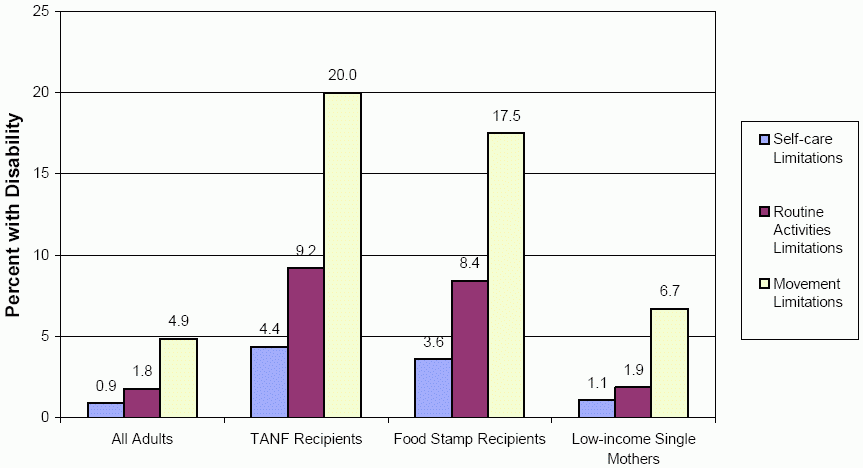
Source: Authors’ calculations from the National Health Interview Survey, 2005/2006.
- A greater percentage of TANF recipients have each of these activity limitations than all adults or low-income single mothers. Prevalence of these limitations among Food Stamp recipients is similar to TANF recipients.
- For all groups, self-care limitations (such as difficulties bathing, dressing, or eating) are less common than difficulties with routine activities (such as everyday household chores, shopping, getting around the house).
- Movement limitations, defined as being unable or having a lot of difficulty carrying out activities that require somewhat greater physical abilities (such as walking a quarter mile, lifting a 10-pound bag of groceries, or walking up ten steps without resting) are the most common. One-fifth of TANF recipients report these limitations.
Exhibit A2.
Adults with Limitations in Participation by Population Group
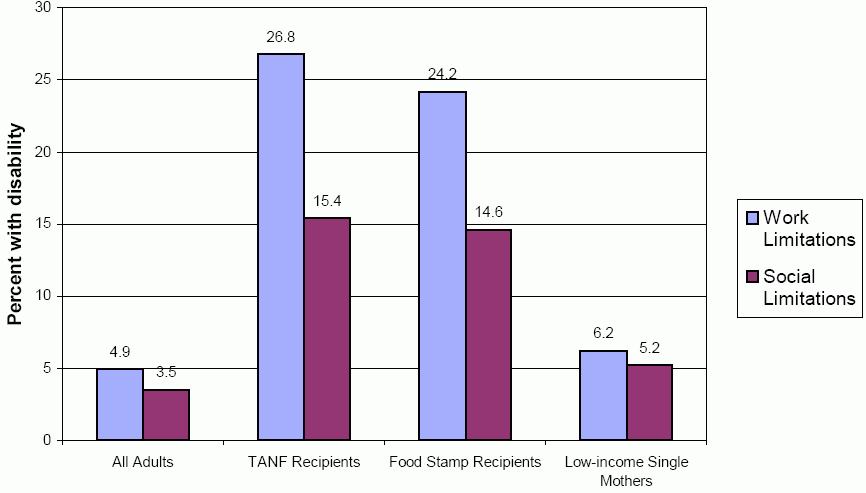
Source: Authors’ calculations from the National Health Interview Survey, 2005/2006.
- More than a quarter of TANF recipients report that they have a physical, mental, or emotional problem that keeps them from working or limits the kind or amount of work they can do. This is one of the most commonly used measures of disability, available in many national data sets. This finding is consistent with prior literature. Acs and Loprest (2007) report that 24.7 percent of TANF recipients in the 2005 Current Population Survey said they had a work limitation, defined in the same way.
- A smaller percentage of people report they find it very difficult or cannot participate in a number of social activities, including going out to things like shopping, movies, sporting events or visiting friends, going to parties, attending clubs, or doing things to relax at home or for leisure (reading, watching TV, sewing, listening to music).
- Compared with TANF recipients, prevalence of these limitations is similar among Food Stamp recipients but substantially lower among low-income single mothers and all adults.
Exhibit A3.
Adults with Sensory or Emotional/Mental Limitations by Population Group
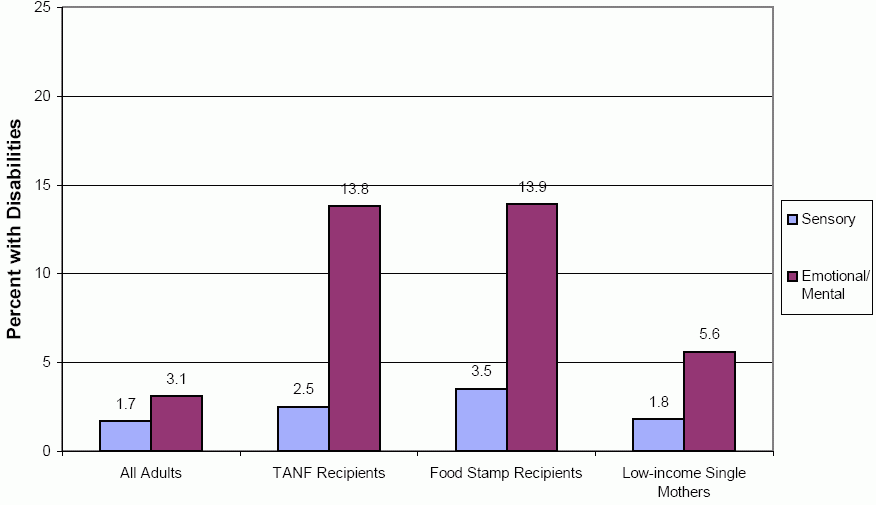
Source: Authors’ calculations from the National Health Interview Survey, 2005/2006.
- Sensory disabilities, defined here as great difficulty or inability to see or hear even with aids (such as glasses or hearing aids), are more prevalent among TANF and Food Stamp recipients than all adults or low-income single mothers. However, they are generally less common than the other measures of disability reported earlier.
- More than a tenth of TANF recipients and Food Stamp recipients have emotional/mental issues defined here as scoring above the cut-off on a commonly used scale of serious psychological distress associated with unspecified serious mental illness (Kessler et al. 2003). This rate is more than four times the percentage of all adults and more than twice the rate of low-income single mothers.
Exhibit A4.
Adults with Cognitive/Memory Problems or Excessive Alcohol Use by Population Group
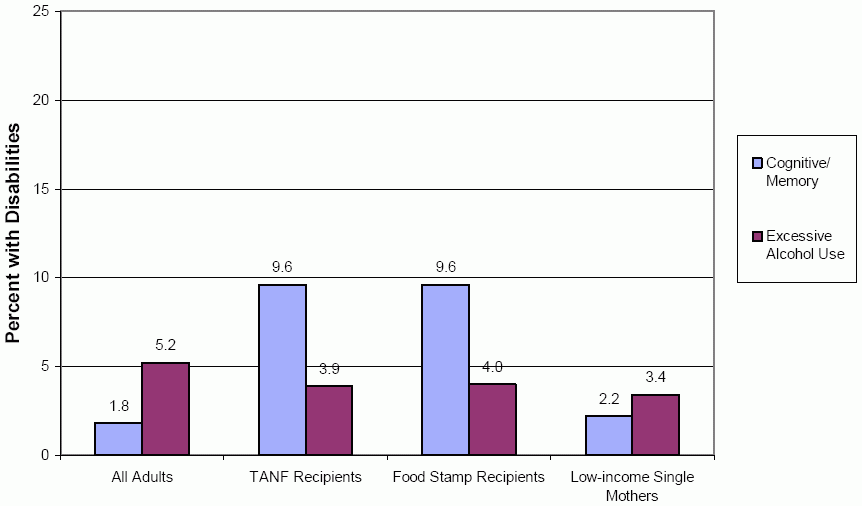
Source: Authors’ calculations from the National Health Interview Survey, 2005/2006.
- About one-tenth of TANF and Food Stamp recipients are limited in some way because they have difficulty in remembering or because they experience periods of confusion. This measure does not capture other types of cognitive issues such as mild mental retardation or learning disabilities, which could also present challenges to some TANF recipients.
- About four percent of TANF recipients and Food Stamp recipients and two percent of low-income mothers report excessive alcohol use, defined as those who consumed greater than or equal to five drinks in one day at least 12 times during the past 12 months. This measure has been correlated to negative health outcomes and behaviors, but is not the same as measures of alcohol abuse or dependence or even binge drinking.(4) This is one of the few measures where the rate for TANF and Food Stamp recipients is lower than or similar to the rate for all adults. This is likely in part related to gender differences in report of excessive alcohol use and the majority of TANF recipients are female.
Exhibit A5.
Receipt of Disability Benefits by Population Group
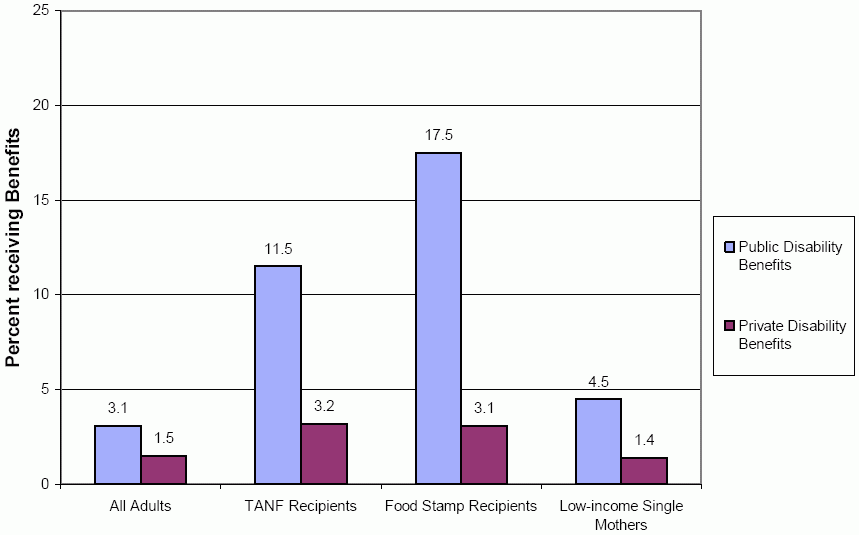
Source: Authors’ calculations from the National Health Interview Survey, 2005/2006.
- More than three times as many TANF recipients and five times as many Food Stamp recipients are receiving public disability benefits than all adults. In part this is because eligibility for one type of public disability benefits, Supplemental Security Income (SSI), is income based.(5)
- A greater percentage of TANF and Food Stamps recipients receive private disability benefits than other adults.(6) Since many of these disability benefits are based on prior employment, which is lower among benefit recipients, this is somewhat surprising. It is possible that low benefit levels and difficulty working may lead these pension recipients to seek public cash assistance.
Exhibit A6.
Composite Measures of Adult Disability

Source: Authors’ calculations from the National Health Interview Survey, 2005/2006.
- About two-fifths of TANF recipients and of Food Stamp recipients have at least one of the prior measures of disability presented (“broad measure”). This is more than twice the rate among all adults and almost double the rate among low-income single mothers.
- Roughly ten percent of TANF recipients and Food Stamp recipients have a disability using the more restrictive composite measure limited to those with self-care limitations or limitations in routine activities (“narrow measure”). This is almost five times the percent of all adults with disabilities reporting this measure.
- Disability by both composite measures is substantially more prevalent among TANF and Food Stamp recipients than low-income single mothers (more than double), whose rates of disability are similar to the rates for all adults.
- Work limitation prevalence (reported earlier in Exhibit A2), a single measure of disability often used in studies of employment, falls in between these two composite measures.
Part B. Family Members with Disabilities
Other Adult Family Members with Disability by Population Group
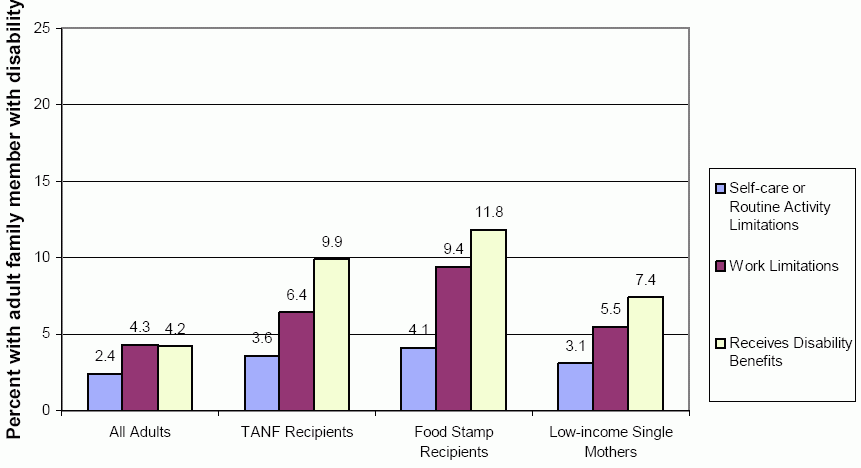
Source: Authors’ calculations from the National Health Interview Survey, 2005/2006
- Less than five percent of TANF recipients and Food Stamp recipients have an adult family member with a self-care or routine activity limitation. This is similar to the rate for low-income single mothers and slightly higher than for all adults.
- In all population groups, having a family member with a work limitation is more common than with a self-care or routine activity limitation. About 6 percent of TANF recipients and 9 percent of Food Stamp recipients have a family member with a work limitation.
- About a tenth of TANF and Food Stamp recipients have a family member that is receiving disability benefits (public or private). This is more than double the rate of all adults with a family member receiving benefits.
- The percentages of recipients with adult family members with disability are lower than the percentages with disabilities themselves in part because many of these recipient families do not include another adult. This is also true for low-income single mothers, most of whom do not have another adult in the family.
Exhibit B2.
Children with Disability by Population Group

Source: Authors’ calculations from the National Health Interview Survey, 2005/2006.
- Almost three percent of TANF recipients and Food Stamp recipients have a child with a self-care or activity limitation. These measures are defined somewhat differently than for adults to consider age appropriate activities for children. A smaller percentage of all adults and low-income single mothers have a child with a disability in the family.
- About three percent of TANF recipients have a child receiving public disability benefits (SSI) with a slightly higher rate among Food Stamp recipients. The rate is somewhat lower for low-income single mothers. Less than one percent of all adults have a child receiving public disability benefits. Acs and Loprest (2007) found similar results using the 2005 CPS — 4.1 percent of TANF recipients had a child receiving SSI.
Exhibit B3.
Composite Measures of Family Member with Disability by Population Group
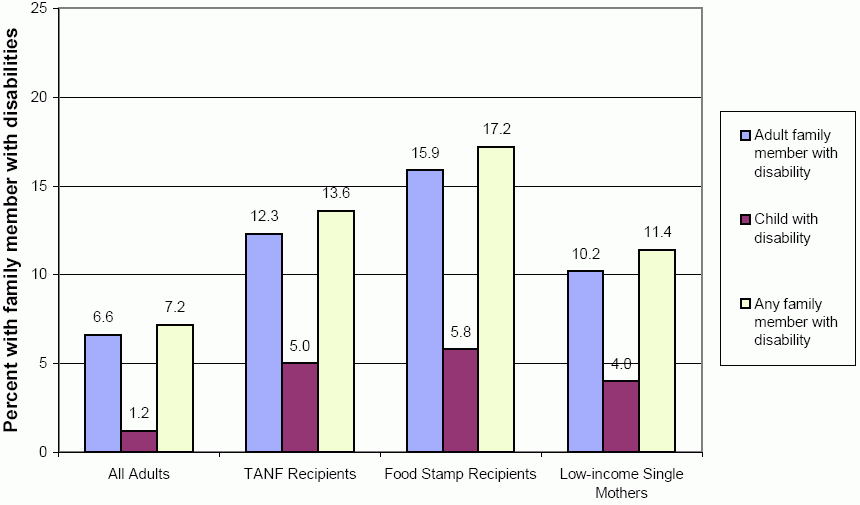
Source: Authors’ calculations from the National Health Interview Survey, 2005/2006.
- Among TANF recipients, 12 percent have another adult family member with a self-care limitation or work limitation or a family member who receives public disability benefits. Five percent of TANF recipients have a child who either receives SSI or has an activity limitation. Altogether, about 14 percent of TANF recipients have a family member with a disability (regardless of their own disability status). This means that some families have both a child and another adult family member with a disability. A slightly higher percentage of Food Stamp recipients have a family member with a disability, 17 percent.
- Fewer low-income single mothers have a family member with a disability than TANF recipients stemming from the lower rate of other adult household members with a disability.
- Seven percent of all adults have a family member with a disability, without taking into account their own disability status.
Exhibit B4.
Composite Head and Family Member with Disability by Population Group
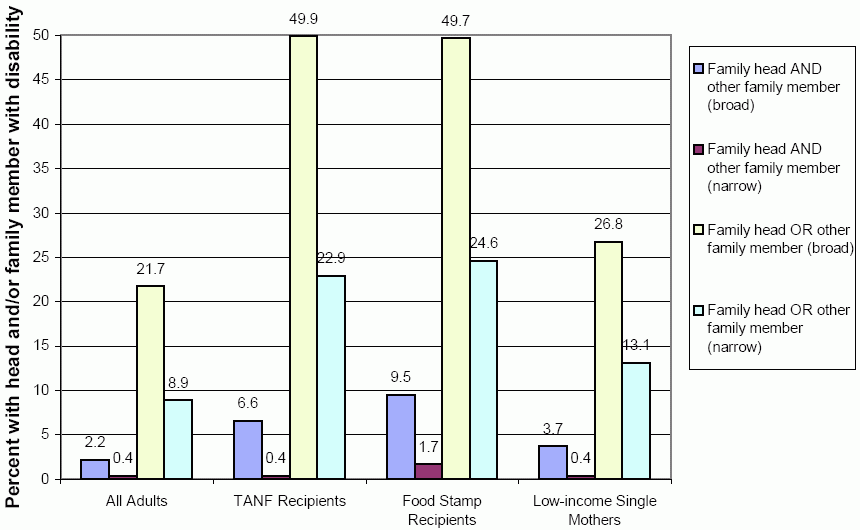
Source: Authors’ calculations from the National Health Interview Survey, 2005/2006.
Note: Family head here refers to the reference adult in the household used in Part A to measure adult disability.
- About half of TANF recipients have a disability themselves or have a family member with a disability, using our broad measure of disability. Even using the more restrictive composite measure of adult disability (individuals with a self-care or routine activity limitation), almost a quarter of TANF recipients have a disability themselves or a family member with a disability. Food Stamp recipients have similar prevalence of disability on these measures as TANF recipients.
- As with all the individual measures of disability, these composite measures of disability are higher among TANF recipients and Food Stamp recipients than low-income single mothers and all adults.
- About 7 percent of TANF recipients have a disability themselves and have a family member with a disability using the broad measure of disability. This is roughly one-sixth of the 43 percent of TANF recipients with a disability using the broad measure (see Exhibit A6). When using the more restrictive definition of adult disability, only half of one percent of recipients has a disability and has a family member with a disability.
Part C. Disability and Employment
Currently Employed by Disability and Population Group

Source: Authors’ calculations from the National Health Interview Survey, 2005/2006.
Note: Broad definition refers to having any of the adult disabilities included in Part A.
Narrow definition refers to having a self-care or routine activity limitation.
- For all groups, the percent currently employed is substantially higher among adults without a disability than those with a disability, by either the broad or narrow measure of disability.
- Only eighteen percent of TANF recipients with a disability are currently employed, using the broad definition of disability, compared to an overall employment rate of 44 percent for TANF recipients without a disability. Results are similar for Food Stamp recipients with disabilities although employment rates for Food Stamp recipients without a disability are higher.
- Using either definition of disability, more than double the percentage of low-income single mothers with a disability are employed than of either TANF or Food Stamp recipients with a disability. This could be due to different individual characteristics of these populations or a greater need for earnings among those not receiving or eligible for TANF or Food Stamp benefits.
- The smaller group of individuals meeting the narrow definition of disability has extremely low rates of employment in all populations reflecting both a more severe level of disability and greater eligibility for public disability benefits.
| Population Group | All adults | TANF recipients |
Food Stamp recipients |
Low-income single mothers |
|---|---|---|---|---|
|
Total population without disability |
||||
| Currently employed | 83.14 (0.29) |
44.15 (3.13) |
59.68 (1.56) |
78.96 (0.98) |
| Currently full-time | 72.62 (0.37) |
29.70 (3.00) |
41.97 (1.60) |
66.03 (1.18) |
| Worked at all last year | 86.95 (0.26) |
56.41 (3.31) |
70.49 (1.47) |
85.27 (0.93) |
|
With a disability (broad definition) |
||||
| Currently employed | 55.33 (0.80) |
18.23 (3.00) |
19.47 (1.51) |
43.84 (2.61) |
| Currently full-time | 46.94 (0.80) |
11.01 (2.55) |
11.29 (1.28) |
33.55 (2.43) |
| Worked at all last year | 64.84 (0.80) |
35.38 (3.58) |
32.56 (1.73) |
57.06 (2.55) |
|
With a disability (narrow definition) |
||||
| Currently employed | 16.44 (1.63) |
3.80 (2.92) |
5.24 (1.75) |
12.25 (3.65) |
| Currently full-time | 9.89 (1.35) |
0.0 | 2.63 (1.35) |
6.85 (2.51) |
| Worked at all last year | 26.27 (1.90) |
25.51 (7.90) |
14.38 (2.68) |
24.39 (4.95) |
| Source: Authors’ calculations from the National Health Interview Survey, 2005/2006. Note: Broad definition refers to having any of the adult disabilities included in Part A. Narrow definition refers to having a self-care or routine activity limitation. |
||||
- The majority of currently employed TANF and Food Stamp recipients with a disability are working full-time. For example, of the 18 percent of TANF recipients with a disability by our broad definition, 60 percent are working full-time, or 11 percent of all TANF recipients.
- A quarter to a third of TANF recipients with a disability worked at some point in the past year, using the narrow and broad disability definition respectively.
- Low-income single mothers’ with a disability generally have substantially higher employment rates than TANF and Food Stamp recipients, by all three measures of employment.
Exhibit C3.
Currently Employed by Own and Family Disability and Population Group
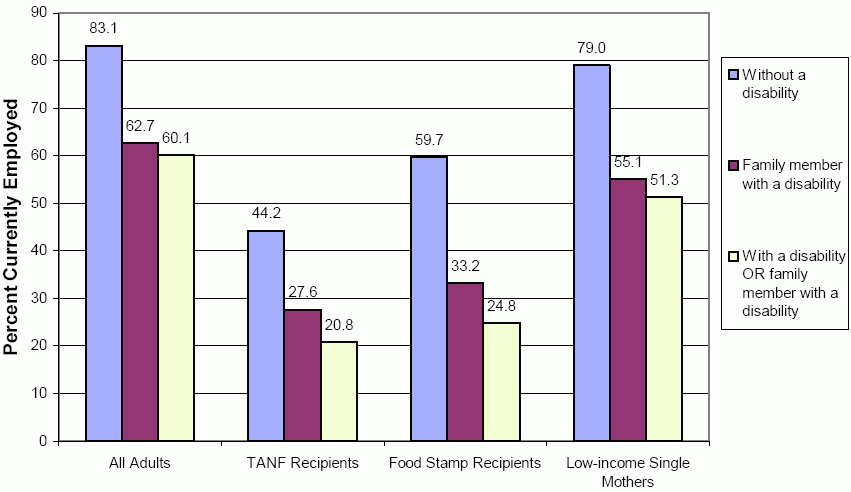
Source: Authors’ calculations from the National Health Interview Survey, 2005/2006.
Note: Adult disability in this exhibit refers to the broad definition of disability — having any of the disabilities included in Part A. Rates using the narrow definition (having a self-care or routine activity limitation) are similar. Samples of those with a disability and a family member with a disability were too small to support employment analysis.
- Only a little more than a quarter of TANF recipients who have a family member with a disability are currently working, compared to 44 percent of those without a disability who are working (repeated from Exhibit C1). This same pattern holds true for all the population groups. This suggests that having a family member with a disability has a negative impact on ability to work. Prior research supports this as well (see Loprest and Zedlewski 2006).
- The employment rate for low-income single mothers who have a family member with a disability is considerably higher than for TANF recipients, 55 percent compared to 28 percent. Again, this could result from differences in the characteristics of these two populations or the impact of receipt of cash assistance on employment.
- Adults that either have a disability themselves or have a family member with a disability have even lower rates of current employment. For TANF recipients the employment rate is 21 percent.
| Population Group | All adults | TANF recipients |
Food Stamp recipients |
Low-income Single Mothers |
|---|---|---|---|---|
| Disability (broad definition), no other family members with disability | 62.0 | 26.7 | 25.1 | 51.1 |
| Disability (narrow definition), no other family members with disability | 20.4 | 3.0 | 6.6 | 15.3 |
| Family member has disability, head has no disability | 73.9 | 20.1 | 54.6 | 68.2 |
| Source: Authors’ calculations from the National Health Interview Survey, 2005/2006. Note: Regression adjustment controls for gender, race, ethnicity, age, education, marital status, and disability measure. Broad definition refers to having any of the adult disabilities included in Part A. Narrow definition refers to having a self-care or routine activity limitation. |
||||
- Even after controlling for characteristics related to employment that differ across the population groups, the patterns of employment rates by disability remain similar.(7) Employment rates are higher among those with a disability using the broad definition as compared to when using the narrow definition.
- Regression adjusted employment rates of TANF and Food Stamp recipients remain low. Only 27 percent of TANF recipients with a disability using the broad definition are working and only 3 percent by the narrow definition. Results for Food Stamps recipients are similar, with 25 percent working using the broad definition and 7 percent using the narrow definition.
- One-fifth of TANF recipients and somewhat more than half of Food Stamp recipients with a family member with a disability are working. These numbers are lower than the unadjusted rates of employment for these populations without disabilities (see Exhibit C1).
- While employment rates for all adults and low-income single mothers with disabilities are higher than the two recipient groups, they are still relatively low. Only 61 percent of all adults with a disability using the broad definition are currently working and only 51 percent of low-income single mothers.
Summary and Conclusion
This report provides information on the prevalence of disability among TANF recipients and their families and the employment rates of those recipients. The major findings can be summarized as follows:
- The prevalence of disability varies greatly depending on the particular measure used. It is important to choose the appropriate measure of disability for the analysis being performed.
- TANF recipients have higher rates of disability than all adults on all measures of disability included in this report. Food Stamp recipients generally have similar rates of disability to TANF recipients. Low-income single mothers generally have disability rates that are higher than all adults, but lower than TANF and Food Stamp recipients.
- Using a broad composite measure of disability which includes the presence of a self-care limitation, a limitation in routine activities or movement, an emotional or mental health limitation, a sensory limitation (vision or hearing), a cognitive limitation, a social limitation, a work limitation, or receiving disability benefits, two-fifths of TANF and Food Stamp recipients have a disability. A more restrictive measure of those with significant limitations in self-care or routine activities finds about one-tenth of each recipient groups has a disability.
- These composite results are consistent with previous results, although prior results using the same composite definitions are not available. Zedlewski (2003) found using the 2002 National Survey of America’s Families that 29 percent of TANF recipients had a very serious physical or mental health condition.(8) This prevalence is lower than our findings in part because it does not include as many different measures of disability.
- About 14 percent of TANF recipients and almost one-fifth of Food Stamp recipients have a family member with a disability (either an adult or a child). This is roughly double the rate for all adults.
- Employment rates among TANF recipients with disabilities are substantially lower than among recipients without disabilities and than all adults with disabilities. About 18 percent of TANF recipients with a disability (using a broad measure of disability) are employed compared to 44 percent of TANF recipients without a disability and 55 percent of adults with disabilities.
References
Acs, Gregory, and Pamela Loprest. 2003. “A Study of the District of Columbia’s TANF Caseload.” Washington, DC: The Urban Institute.
———. 2007. “TANF Caseload Composition and Leavers Synthesis Report.” Washington, DC: The Urban Institute.
Altman, B., and Amy Bernstein. 2008. Disability and Health in the United States, 2001–2005. Hyattsville, MD: National Center for Health Statistics.
Centers for Disease Control and Prevention. 2004. Morbidity and Mortality Weekly Report. 53(37);866-870.
Harris, Benjamin, Gerry Hendershot, and David Stapleton. 2005. “A Guide to Disability Statistics from the National Health Interview Survey.” Report to the Rehabilitation Research and Training Center on Disability Demographics and Statistics Cornell University.
Hauan, Susan, and Sarah Douglas. 2004. “Potential Employment Liabilities among TANF Recipients: A Synthesis of Data from Six State TANF Caseload Studies.” Washington, DC: U.S. Department of Health and Human Services.
Kessler, Ronald C., Peggy Barker, Lisa Colpe, Joan F. Epstein, Joseph C. Gfroerer, Eva Hiripi, Mary J. Howes, Sharon-Lise T. Normand, Ronald W. Manderscheid, Ellen E. Walters, Alan M. Zaslavsky. 2003. “Screening for Serious Mental Illness in the General Population” Archives of General Psychiatry 60(2): 184-189.
Loprest, Pamela, and Gregory Acs. 1996. “Profile of Disabilities among Families on AFDC.” Washington, DC: The Urban Institute.
Loprest, Pamela, and Sheila Zedlewski. 2006. The Changing Role of Welfare in the Lives of Low-Income Families with Children. Occasional Paper 73. Washington, DC: The Urban Institute.
Polit, Denise, Andrew London, and John Martinez. 2001. “The Health of Poor Urban Women: Finding from the Project on Devolution and Urban Change.” Manpower Demonstration Research Corporation.
Zedlewski, Sheila. 2003. “Work and Barriers to Work among Welfare Recipients in 2002.” Assessing the New Federalism, Snapshots of America’s Families III, no. 3. Washington, DC: The Urban Institute.
Zedlewski, Sheila, and Pamela Loprest. 2001. “Will TANF Work for the Most Disadvantaged Families?” In The New World of Welfare, edited by Rebecca Blank and Ron Haskins. Washington, DC: Brookings Institution Press.
Appendix
This appendix defines the measures used in this report and the National Health Interview Survey (NHIS) variables used to create each measure. It also includes a description of our comparison groups and definitions for work that are used in the report.
Family Head Disability Measures
- Self-care limitations — Activities of Daily Living (ADLs) – because of a physical, mental, or emotional problem, person needs the help of others with personal care needs such as eating, bathing, dressing, or getting around inside this home.
- Routine activities limitations — Instrumental Activities of Daily Living (IADLs) – because of a physical mental or emotional problem, person needs the help of others in handling routine needs such as everyday household chores, doing necessary business, shopping, or getting around for other purposes.
- Movement — person says, because of a health problem, they can’t do at all or it is very difficult to do any one of the following by themselves without the use of special equipment: walk a quarter of a mile (about three city blocks); walk up 10 steps without resting; stand or be on your feet for about two hours; sit for about two hours; stoop, bend, or kneel; reach over your head; use your fingers to grasp or handle small objects; lift or carry something as heavy as 10 pounds such as a bag full of groceries; push or pull large objects like a living room chair. (Those reporting they do not do a specific activity are not counted as having a movement limitation.)
- Emotional/mental — A score of 13 or greater on the K6 serious psychological distress scale which measures psychological distress associated with unspecified but serious mental illness.(9)
- Sensory — person describes their hearing ability without a hearing aid as “a lot of trouble” or deaf OR person reports they are blind and unable to se at all.
- Cognitive — person is limited in any way because of difficulty in remembering or because they experience periods of confusion.
- Social limitations — person reports they can’t do at all or it is very difficult to do any one of the following: go out to things like shopping, movies, or sporting events; participate in social activities such as visiting friends, attending clubs and meetings, going to parties; do thing to relax at home or for leisure (reading, watching TV, sewing, listening to music). (Those reporting they do not do a specific activity are not counted as having a social limitation.)
- Work limitations — a physical, mental, or emotional problem now keeps the person from working at a job or businesses OR limits the kind or amount of work a person can do.
- Public Disability Benefit Recipient — the receipt of government sponsored disability benefits - Supplemental Security Income, Social Security, or Railroad Retirement income, for one’s own disability in the previous year.
- Private Disability Benefit Recipient — receipt of income from any disability pension other than Social Security or Railroad Retirement in the previous year.
- Excessive Alcohol Use — consumed greater than or equal to five drinks in one day at least 12 times during the past 12 months.(10)
- Disability1 — In any of the above categories 1 through 11
- Disability2 — In category #1 (self-care) or #2 (routine needs)
Disability among Family Members
- Other Adult Disability1 — other adult family member has self-care or routine activity limitations as defined above
- Other Adult Disability2 — other adult family member has work limitations as defined above
- Other Adult Disability3 — other adult family member receives government disability benefits (SSI/DI/RR) or private disability benefits
- Child Disability1 — child family member (age 3+) has self-care limitation OR child family member (age 0-4) is limited or unable to participate in age-appropriate play
- Child Disability2 — child receives public disability benefits (SSI)
- Family Disability — any family member in any of the above five family definitions
Combined Family Head and Member Disability
- Head and Family1 — Family head has disability (Disability1 above) and Family Disability
- Head and Family2 — Family head has disability (Disability2 above) and Family Disability
- Head or Familly1 — Family head has disability (Disability1 above) or Family Disability
- Head or Family2 — Family head has disability (Disability2 above) or Family Disability
One important consideration in using the NHIS to measure disability is that some questions are asked for all family members while others are asked only of sample adults or sample children. This means that adults or children are chosen at random from all those in the family to respond to certain sets of questions. Using appropriate weighting, these sample family member questions can be used to provide prevalence estimates for adults or children. However, this structure limits our ability to use these questions to create estimates of TANF recipients who have a family member with a disability or to create composite measures of disability. For example, since questions on physical movement limitations are asked only of sample adults, we cannot provide estimates of the percentage of TANF recipients who have a family member with these limitations. In the same way, a measure of adults who report any of the many disability measures we include is not symmetrically constructed if some adults are asked more disability questions than others. For this reason, we limit our sample to adults who are chosen as the sample respondent. This limits our sample size but allows us to use a broader array of disability measures.
Sample / Comparison Group Definition Measures
The three groups for comparison in the study are individuals ages 21 to 55 defined as follows.
- TANF Recipients - defined as individuals responding that someone in the family received cash assistance for at least one month in the prior year from a state or county welfare program.
- Food Stamp Recipients - defined as individuals that responded someone in the family received food stamps at any time in the last calendar year.
- Low-Income Single Mother Families – defined as single women with children whose family income was less than 200 percent of poverty in the prior year.
We start with age 21 because marital status in the NHIS is not defined for those under age 21. Because we are primarily concerned with work status, we do not include individuals beyond age 55.
Definitions of Work
The survey asks about work in the last week as well as work in the past year. We report on three definitions of work: current work which is measured at the same time as the disability measures, full-time current work, and a broader measure of worked last year.
- Employed – Those working for pay at a job or business or with a job or business but not at work in the past week
- Full-time Employed – Those employed (above) who usually work 35 hours or more a week.
- Employed Last Year – Those who worked for pay at any time in the last year.
Endnotes
1. A complete description of all measures used and how they are created using the NHIS data is provided in the Appendix.
2. Low-income single moms are defined as families with only a mother and biological or non-biological children living together with or without other related adults. Mothers with cohabiting partners are not included in this definition. Low-income is defined as income less than 200 percent of the poverty line.
3. Further discussion of the randomly chosen adult issue can be found in the Appendix.
4. This is the only measure of substance use or abuse asked about in the regular NHIS. While it is not a measure of disability, it has been correlated with serious health problems and loss of life (Centers for Disease Control and Prevention 2004).
5. Individuals cannot receive both TANF and SSI cash assistance. However, since both of these program participation numbers are measured as receipt at any time in the past year, individuals may be receiving these two benefits at different times. It is also possible that the adult is receiving SSI while another household member is receiving TANF benefits.
6. The difference is not statistically significant. We call these private here, but they also include workers compensation benefits.
7. To calculate employment rates, all characteristics are held at their mean, except for the characteristic of interest.
8. This measure is a combination of the work limitation measure used in this report and a scale for mental health issues similar to that used in this report.
9. The index has been shown to be a good predictor of unspecified serious mental illness (Kessler et al. 2003). The scale is based on weighting responses to how often during the past 30 days did the person feel each of the following: so sad nothing could cheer you up; nervous; restless or fidgety; hopeless; that everything was an effort; worthless.
10. This is not the same as measures of alcohol abuse or dependence. It is a subset of the measure “binge drinking” which is defined as 5 or more drinks in one day for men or 4 or more drinks in one day for women at some point in the past 30 days. While it is not a measure of disability per se, this measure has been correlated to serious negative health outcomes and behaviors and loss of life (Centers for Disease Control and Prevention 2004). The core NHIS does not have a measure of non-alcohol substance use, abuse or dependence.
